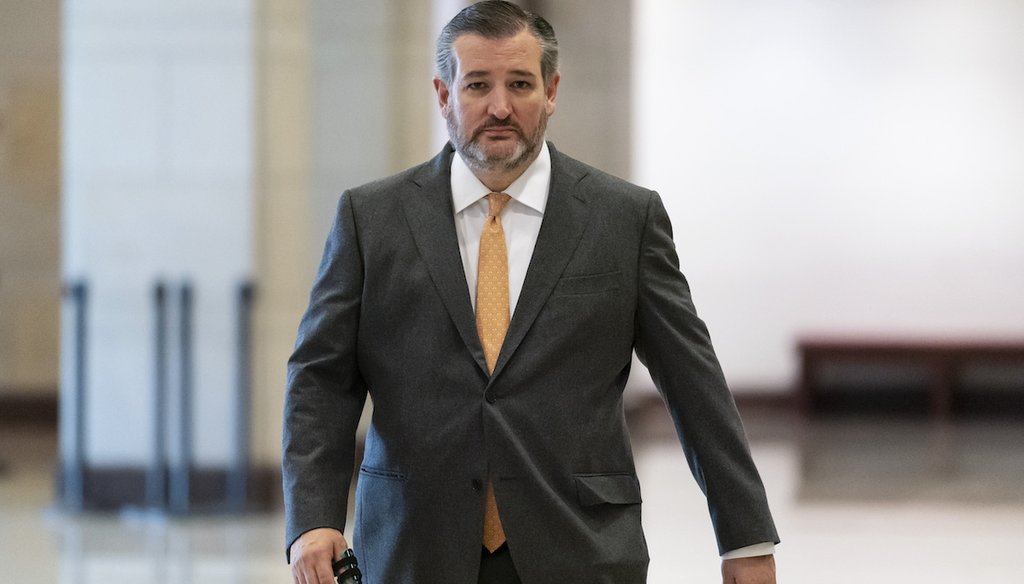Stand up for the facts!
Our only agenda is to publish the truth so you can be an informed participant in democracy.
We need your help.
I would like to contribute

Sen. Ted Cruz, R-Texas, arrives for a closed-door briefing on Afghanistan on Capitol Hill in Washington, Feb. 2, 2022. (AP)
If Your Time is short
- Sen. Ted Cruz tweeted criticism of President Joe Biden and Democrats in what he called the "Real State of the Union" the evening of Biden's first State of the Union
- Cruz was accurate about inflation and jobs statistics. Trends about wages depends on what numbers you look.
U.S. Sen. Ted Cruz, R-Texas, took to Twitter during President Joe Biden's first State of the Union address to critique the speech.
Inflation and the economy were a big focus of the tweets, but there were also tweets on Ukraine, the border, and more. Cruz called his commentary "The Real State of the Union."
We took a look at some of Cruz's claims on the economy.
Biden said the economy created over 6.5 million new jobs last year, "more jobs in one year than ever before in the history of the United States of America." U.S. jobs numbers took a huge hit because of the pandemic. The pandemic has reshaped industries and created a steep path to recovery.
In checking Biden's claim, PolitiFact reported more jobs were added in 2021 than in any previous year, but 2021 was not the biggest one-year percentage increase.
Cruz pointed out that there are 2.87 million fewer jobs in the U.S. than in February 2020. He was accurate based on the data available on the day of the State of the Union on March 1.
That data comes out of the Current Employment Statistics program at the Bureau of Labor Statistics that estimates nonfarm employment, hours, and earnings by industry.
A March 4 Bureau of Labor Statistics release reported employment rose by 678,000 jobs in February, and gains were widespread.
The Consumer Price Index rose 7.5% between January 2021 and January 2022, before seasonal adjustment. That index tracks the price of certain goods and services such as food, energy, new vehicles, used vehicles, apparel, and medical care.
Overall, the index saw the largest one-year increase since 1982— so Cruz was right about the highest inflation.
James DeNicco, director of the Principles of Economics Program at Rice University, told PolitiFact Texas when you "prop up" the economy with trillions of dollars of spending, this plays a big role in inflation.
The overall recovery of the economy from the pandemic's initial economic shock was made possible by 2020 policies — during the Trump administration — to distribute money for pandemic relief and more, said James Galbraith, an economist at the LBJ School of Public Affairs at the University of Texas, in a March 3 email.
"It would be difficult to attribute the spending programs that led to the rapid recovery in late 2020 and early 2021 to Democrats alone, since at the time the incumbent President was a Republican and the Senate was under Republican leadership," Galbraith wrote.
A March 10 Bureau of Labor Statistics report indicates inflation reached another 40-year high. From February 2021 to February 2022, the prices indexed increased 7.9%.
Cruz is referring to the Consumer Price Index that measures the average change over time of consumer prices. That 1.4% checks out as the percent change from January 2020 to January 2021, during the Trump presidency. The one-year change between January 2021 and January 2022 was 7.5%.
Cruz's office pointed to AAA data for the price of gas on Jan. 19, 2021 and on March 1.
U.S. Energy Information Administration data indicates the national average price of a gallon of gasoline for the week of Jan. 18, 2021, when Trump left office, was $2.38; It was $3.61 the week of Feb. 28, 2022.
Gas prices were as low as $1.77 in April 2020 when stay-at-home precautions were in place to curb the spread of the coronavirus. They rose to $2 in June 2020 and reached $3 in May 2021.
Cruz's numbers are from that report of the Consumer Price Index and match the percent changes from January 2021 to January 2022.
Increases in the prices of food, electricity, and shelter drove the overall increase in the index.
Energy prices are surging again due to the war in Ukraine, Galbraith wrote, and the big increase before that was in early 2021 "due to a rebound of demand and prices from the lows of 2020, which were due to the pandemic."
"Used car prices surged mainly due to supply chain disruptions affecting new cars, mainly in the semiconductor supply chain," Galbraith wrote.
Cruz's office pointed to a Jan. 22 Washington Post article, "'That raise meant nothing': Inflation is wiping out pay increases for most Americans" that mapped year-to-year change in earnings unadjusted and adjusted for inflation.
The article's chart showed a trend of wage gain before 2021. DeNicco also described this same wage trend over the last several years.
The Washington Post chart shows year-over-year changes in inflation-adjusted earnings were positive from July 2018 to March 2021. That means earnings were higher that month than in the previous year.
Between March and April 2021, the year-over-year percent change in earnings went from positive (inflation-adjusted wages increased by 1.6% from March 2020 to March 2021) to negative (inflation-adjusted wages decreased by 3.7% from April 2020 to April 2021).
From April to December 2021, inflation-adjusted earnings were less that month than they were in 2020.
Understanding wage patterns also depends on what numbers you look at. Josh Bivens, research director of the left-leaning Economic Policy Institute, wrote in an email to PolitiFact Texas the statement does not seem accurate.
"Simple fact is that real wages and incomes are higher today than 3 years ago for sure. So, nothing has 'erased' wage gains – wages are higher today," Bivens said.
Cruz's claim is based on a January article from the Washington Examiner, which makes assumptions based on analyses by the Congressional Budget Office and the nonpartisan Penn Wharton Budget Model.
The Penn Wharton Budget Model estimated the average U.S. household spent around $3,500 more in 2021 to achieve the same level of consumption as previous years because of inflation.
The Congressional Budget Office document estimated a 1% increase in income (unadjusted for inflation) would lead to a relative 1.1% increase in individual income taxes. But that document does not indicate the tax increase would equal $1,500.
Cruz said, "The inflation tax is crushing the American middle class, costing the average U.S. household a staggering $5,000 a year." Penn Wharton estimated $3,500, so where did the other $1,500 come from?
Using the CBO's estimated tax increase percentage, the January Washington Examiner article assumed nominal income increased at the same rate as inflation to make a $1,500 estimate. Economist Zheli He, on behalf of the Penn Wharton Budget Model team, noted nominal income may not have increased at the same rate as inflation.
Texas A&M University economics professor Dennis Jansen wrote to PolitiFact Texas you could arrive at a $5,000 estimate using the January 2022 inflation rate and the 2020 U.S. median family or household incomes.
A congressional Joint Economic Committee report also presented some numbers: average inflation cost per household accelerated to over $380 in January 2022 from about $100 in April.
Our Sources
Tweets by Senator Ted Cruz (@SenTedCruz), March 1, 2022
Emails from Steve Guest, Special adviser for communications at the office of Senator Ted Cruz, March 7, 2022
Christopher Rugaber, "Inflation at 40-year high pressures consumers, Fed and Biden," Jan. 12, 2022
Louis Jacobson, PolitiFact, "Fact-checking Joe Biden's State of the Union claim on scale of job gains in 2021," March 1, 2022
Bureau of Labor Statistics, "Consumer Price Index Summary," Feb. 10, 2022
AAA Gas Prices, Jan. 19, 2021
AAA Gas Prices (utilizing Wayback Machine), March 3, 2022
Bureau of the Fiscal Service (usaspending.gov) under the U.S. Department of the Treasury, "How much money did the federal government collect and spend in 2021?" website accessed March 7, 2022
Bureau of the Fiscal Service (usaspending.gov) under the U.S. Department of the Treasury, "The Federal Response to COVID-19," website accessed March 7, 2022
Email from Dennis Jansen, a professor of economics at Texas A&M University, March 3, 2022
Email from James Galbraith at the University of Texas at Austin Lyndon B. Johnson School of Public Affairs, March 3, 2022
Email from Josh Bivens, director of research at the Economic Policy Institute, March 3, 2022
Louis Jacobson, PolitiFact, "Mitt Romney jab over 7% inflation ignores rising wages," Jan. 20, 2022
Bureau of Labor Statistics, "Employment Situation Summary," March 4, 2022 release
Bureau of Labor Statistics, "Consumer Price Index Summary, "Feb. 10, 2022 release
Bureau of Labor Statistics, "Real Earnings – July 2018"
PolitiFact Staff, "Gas prices were '$1.86 when I left' the White House," Dec. 8, 2021
U.S. Energy Information Administration, "Petroleum & Other Liquids: Weekly U.S. Regular All Formulations Retail Gasoline Prices."
Phone interview with James DeNicco, director of Principles of Economics Program and Senior Lecturer at Rice University, March 4, 2022
Email from Zheli He economist at the Penn Wharton Budget Model on behalf of He, Xiaoyue Sun, and Alexander D Arnon at the University of Pennsylvania's The Wharton School, March 3, 2022 and March 7, 2022
Penn Wharton Budget Model, "Impact of Inflation by Household Income," Dec. 15, 2021
Penn Wharton Budget Model, "Did Wages Keep Up With Inflation in 2021?" Feb. 22, 2022
GOP members of Committee on Ways and Means, "Majority of Americans Believe Bidenflation Is a Serious Problem, Not Just Media Hype," Feb. 25, 2022
Bruce Thompson, "New evidence that Democrats are seeking a massive inflation booster shot," Jan. 11, 2022
Jackie Benson, Senior Economist, United States Congress Joint Economic Committee, "How Much is Inflation Costing you? It Depends on Where You Live," March 2, 2022
Abha Bhattarai, The Washington Post, "'That raise meant nothing': Inflation is wiping out pay increases for most Americans," Jan. 22, 2022



































